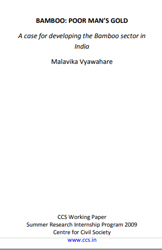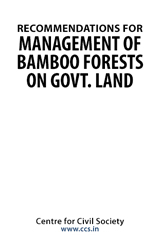Is it a tree? Is it a shrub? Is it a weed? No, it is a grass silly! This modified version of the 'Is it a plane, is it a bird?' joke sits well on the predicament of that the Central government finds itself in with regard to Bamboo in our country. A nearly eight decade old legislation viz. the Indian Forests Act (1927) classifies a scientifically recognised grass as a tree. It is a blunder, a costly one. With 1500 documented uses including as a building material, as medicine and even fibre, Bamboo is one of the most useful plants available to mankind. Apart from this mindboggling range of products, Bamboo has other properties which make it invaluable to us:
- It has a short growth cycle which makes it highly renewable (the commercially important species mature in 4- 5 years as opposed to 10-20 years for trees)
- Different parts of the plant have different uses and are obtained at different stages of its growth thus rendering the plant useful during its entire life span
- Bamboo shoots of some species are edible and have high nutritional value
- The plant improves the environment in many significant ways including acting as an atmospheric and soil purifier.
- It is hardy, light and flexible, thus a good substitute for wood. Many cultures regard it has a miracle plant with even our very own Rig Veda invoking the Gods to – Bestow upon us a hundred Bamboo clumps'.
Unfortunately the perception of Bamboo as poor man's timber became widespread as it was used as a substitute for wood for daily use items by those who did not have access to timber. The government it seems took the phrase literally in clubbing together Bamboo with trees and thus effectively subjecting it to the highly restrictive Forest Laws. As a result the poor man's timber was no longer freely available to the poor man himself. The harvesting, trade and transit regulations have adversely affected the forest dependent communities most, especially those who were involved in traditional Bamboo handicrafts making. Ironically the Indian Forest Policy of 1952 clearly subjugated the interests of the forest dependent communities to its own interests and to that of the industry. The objective was to retain State monopoly in collection and distribution of forest produce like Bamboo, to secure a steady source of revenue and to provide subsidised raw materials for the industry. Bamboo came to be used mostly in the paper and pulp industry. It was only with the issue of the New Forest Policy 1988 that the first right of the forest dependent communities including tribals, been recognised on minor forest produce. There have been two important developments since- the timber ban of 1996 and the passing of the Scheduled Tribes and Other Traditional Forest Dwellers Act 2006. While the first was instituted by the Honourable Supreme Court to conserve forests and prevent their exploitation for commercial purposes, the legislative action that came nearly a decade later was in line with the second major objective of the New Forest Policy- securing the requirements of forest dependent communities.
The only glitch is Bamboo is effectively excluded from the provisions of the new act, because though the Supreme Court has clearly stated in its ruling that Bamboo is to be treated as a grass, the IFA has not been amended. Further in 10 out of the 27 states where two or more commercially important species of bamboo are grown, IFA is the primary legislation i.e. these states follow the definitional pattern of the IFA while framing their rules and laws. Forests being a concurrent subject, both central and state governments are empowered to legislate. Not only are the legislations flawed the institutions executing them leave much to be desired. The inherent non-participatory nature of the forest management system and the inequitable forest tenure system apart even in states where the Joint Forestry Management System has been put in place, Bamboo has been excluded from being managed by the people. The multitude of laws and the complexity makes it hard for a small grower to fathom exactly what rights he has with regard to Bamboo. The Forest Department has been reluctant to give up its claim on Bamboo resources on which it has hitherto had extensive monopoly, with the Ministry of Environment and Forests and the Ministry of Science and Technology being involved in a rather public dispute over who has control over Bamboo. What we really need is to recognise the people's control over the Bamboo resources in this country, not only over the Bamboo grown in the government forests but also to grow Bamboo on their own land without the government's intervention. Many studies have revealed that the productivity of Bamboo on private lands is much higher than on government lands. In-fact the low average productivity in India i.e. 1.5 Million Tonnes/ ha which is one fifth of that in China is largely the result of poor management of the resource by the concerned government department.
Bamboo is not an ordinary grass, its erratic flowering patterns make regeneration difficult thus harvesting and cultivation techniques have to be scientific. Private plantations with intensive care thus yield the best results. However to argue for the government turning its back completely on Bamboo is foolhardy. Despite its widespread availability, the markets in India are largely for low value traditional Bamboo goods. If the poor people have to extract the maximum out of a market based system for Bamboo, the initial investment in Research and Development, discovery of markets and dissemination of information for these products will have to come from the government. It must also ensure that the provisions of the latest act are implemented properly, as nearly 147 million people live in the vicinity of forests and out of which 34 million tribals depend on NTFPs for their livelihood requirement. While Acts like NREGA are at best short term solutions to the unemployment problems, only the development of people friendly sectors like this would ensure livelihood security for the poor in the long run. Not only is bamboo useful from the equity point of view it is also makes economic sense both for the rural poor and the government itself. The use of Bamboo in public goods alone it has been calculated will save nearly Rupees 7,000 crore annually on purchases of wood and wooden products! With the idea of a Green Economy taking root, it is safe to assume that Bamboo is a material of the future.




